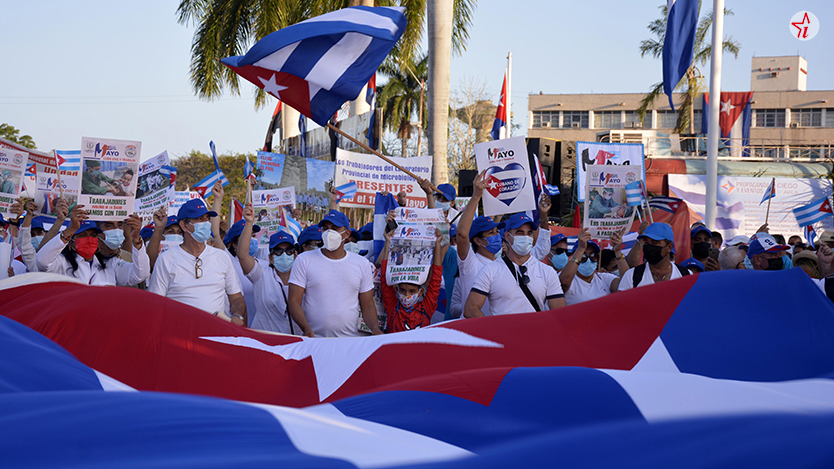
The pause imposed by COVID-19 in Ciego de Ávila was broken on May 1st by a massive, colorful and enthusiastic parade, which filled the streets and the Máximo Gómez square, as if two years had not passed since the last time.
At 7:00 in the morning the march began, led by the presidency, with Humberto Camilo Hernández Suárez, member of the Central Committee of the Communist Party of Cuba and Head of the Department of Cadre Politics, at the top. Jorge Luis Tapia Fonseca and Liván Izquierdo Alonso, both members of the Central Committee, deputy prime minister and first secretary of the PCC in the province, respectively, accompanied him.
The governor of the province, Tomás Alexis Martín Venegas, also presided over the parade; Julio Andrés García Pérez, president of Azcuba; Néstor Hernández Martínez, general secretary of the National Union of Agricultural, Forestry and Tobacco Workers; and Niurka Ferrer Castillo, secretary general of the Provincial Committee of the Workers Union of Cuba.
Precisely Ferrer Castillo was in charge of the central words of the act that preceded the parade. The union leader said that the Ciego de Ávila proletariat is aware of the complex global and national economic scenario, intensified by the US blockade and the pandemic, but at the same time understands and is committed to raise productivity and efficiency, in pursuit of achieving the prosperity that our people deserve.
Next, the combatants of the Cuban Revolution paraded and the Public Health workers’ union, heroes of the confrontation with COVID-19 for more than two years, opened the march. The first ones were the nurses, an advanced contingent, self-sacrificing and devoted to the health of Ciego de Ávila`s citizens.
It was followed by the blocks of Energy and Mines, Education, Science and Sports, Culture, Commerce, Gastronomy and Services, the Sugar Producers, and the very large Construction union. Workers from the Communications, Food Industry, Agricultural, Forestry and Tobacco, Industries and Public Administration unions also passed in front of the stage.
After the Transport and Ports blocks, Hotels and Tourism followed, with a very broad representation of the builders of the Military Construction Union, who made a difference due to the enthusiasm and color displayed. The Civil Defense union closed the proletarian march.
The culmination of the parade was staged by 170 students from secondary and higher education, in salute to the 60th anniversary of the Union of Young Communists and the 170th anniversary of the birth of José Martí. Next to them a group of equestrians, symbolizing the rebel cavalry.
At the conclusion of the proletarian party, the first secretary of the PCC in Ciego de Ávila, Liván Izquierdo Alonso, said to Invasor that the people of Ciego de Ávila gave a resounding response, ratifying their commitment to the Revolution. “This population is very revolutionary and they have shown it today. Let them know that we are going for more, with our #CiegodeÁvilaHeartbeat”.
He also commented that the main challenge for the province is to become one of the most productive in the country. "We will do it by working tirelessly, each fulfilling their mission, in their job, without losing a day."
That conviction had been planted here by the now Vice Prime Minister Jorge Luis Tapia Fonseca, when he served as provincial political leader. Tapia told Invasor this Sunday that Ciego de Ávila has always shown that it is possible. At the same time, he called for increasing the productive and satisfaction indicators of the people.
As it is traditional, Ciego de Ávila citizens paraded and stayed near the plaza and the City Park fair, to enjoy gastronomic offers and the concert by singer-songwriter Arnaldo Rodríguez and his Talismán orchestra.
According to estimates by the provincial CTC, some 200, citizens paraded in Ciego de Ávila on International Workers' Day, as the parade also took to the streets of towns and municipal capitals.
